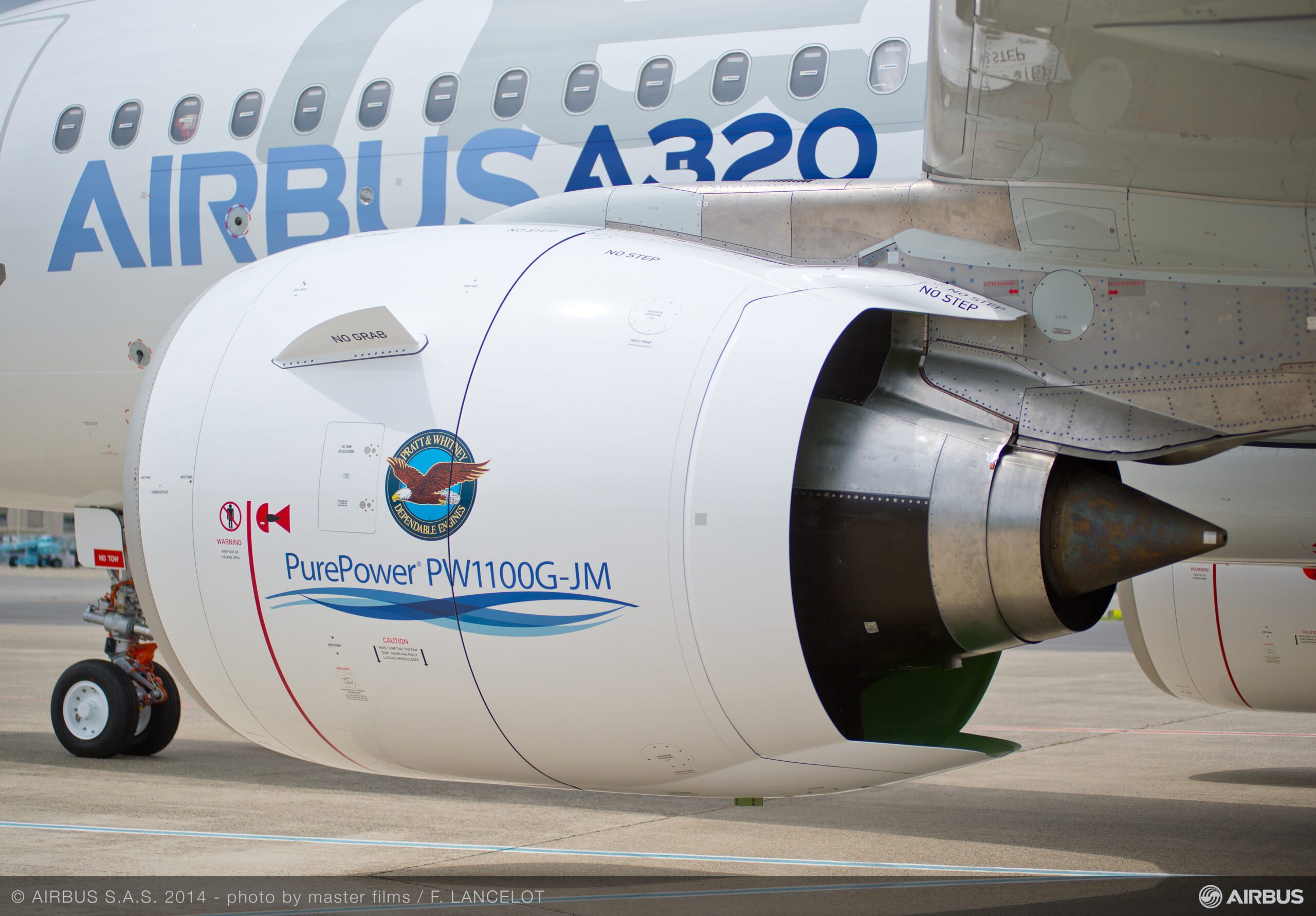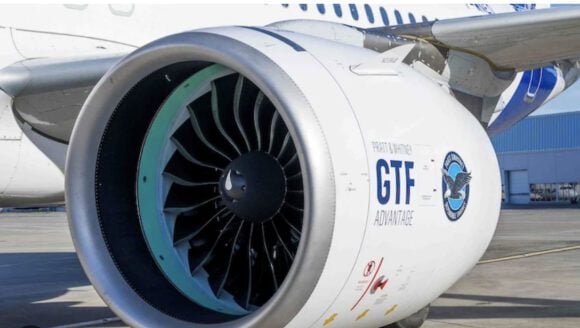
A320neo PW engine close up scaled
Deliveries of Pratt & Whitney Geared Turbofan (GTF) engines for the Airbus A320neo family alone should reach 1.000 per year in 2024 and even 1.200 to 1.300 engines from 2027 through 2030. Until the end of this decade, over 10.000 GTF engines will need to be delivered, engine makers MTU Aero Engines said on November 17 during its Capital Markets Day in London. MTU predicts 1.000 GTF deliveries for the A320neo in 2024.
MTU Aero Engines is a risk-sharing partner in the GTF program, with a share of fifteen to eighteen percent depending on the engine version. One-third of the PW1100G-JM engines that power the A320neo family are being assembled in Munich. Other versions are the PW1500G for the A220 and the PW1900G for the Embraer E2-series. The German company produces the Low-Pressure Turbine (LPT) and the first four stages of the High-Pressure Compressor (HPC). It also manufactures brush seals and nickel blisks for the HPC.
The backlog of GTF-powered aircraft has grown year-on-year, from 458 to 536 for the A220, and from 5.661 to 6.157 for the A320neo family. The updated GTF Advantage started flight testing in October. “There is likely to be a strong rise in production volumes of engines for the A320neo and regional aircraft as well as for business jets. Production of engines for widebody aircraft should also pick up slowly. Overall, the jet engine fleet with MTU participation should increase by 6.1 percent a year up to 2030. That opens up excellent prospects for us,” said MTU’s Chief Program Officer Michael Schreyögg.
As the numbers go up and margins become better, the GTF will become a key revenue and profit contributor for MTU by the end of this decade, especially now that the production is “re-ramped up” and accelerated. Schreyögg said that the rate of 65 A320neo-aircraft per month, which Airbus has planned from early 2024, has been confirmed while higher rates are being discussed as Airbus wants to grow to rate 75 in 2025. “Of course, we are closely monitoring the abilities of a ramp-up in the wider supply chain for forged parts and castings, but we are committed to support demand.”
MTU predicts PW1100G-JM production to reach 1.000 engines in 2024. (MTU Aero Engines)
MTU has taken steps to mitigate the significant supply chain disturbances that have impacted engine parts production for some time but which are stabilizing. It says it is covered through long-term (eight to ten years) contracts with alloy and part suppliers. It also has intensified multi-sourcing, which includes more in-house manufacturing to 32 percent of all procurements. The production capacity will be continuously expanded and more automation introduced. Although Russian titanium is not on the international sanctions list, MTU was quick to seek alternative suppliers in Japan, Australia, and South Africa to cover its titanium requirements of 500 tons per year.
One area in which MTU expects to improve the margins of the GTF program is aftermarket and maintenance. “We not only sell the engine, but we also sell the insurance solution, which is the aftermarket contract which is a ten-years, fixed-price contract. Now, for us, it is an opportunity with Pratt & Whitney and our Japanese partners to bring our knowledge together to reduce maintenance costs. By doing so, the margin is going to expand for the entire partnership,” said Schreyögg. MTU and P&W target to optimize the existing fleet, improve reliability, and enhance on-wing time to reduce maintenance costs. After entry into service in 2016, the GTF had a troubled start with various technical problems. Schreyögg said that on-wing reliability has improved significantly since these early years and is now getting in line with other engine programs. It should be even better on the GTF Advantage.
V2500 remains a key revenue driver
But it isn’t just the GTF that should make good money for MTU. There are still over 3.000 V2500s out there in service on the Airbus A320ceo family and the Embraer C-390 multirole transporter that will need servicing. Their useful life will be extended as new aircraft deliveries remain behind demand and more and more A321ceo’s are converted into full-freighter aircraft. “The V2500 will remain a key revenue driver for many years to come, at least for the next fifteen years”, said Schreyögg, thanks to increased utilization and low retirement rates. The average age is just 12.5 years, which means that 65 percent of all engines haven’t seen second shop visits yet. Other engines which contribute to MTU’s revenues are the PW2000, the GP-7200, as well as the General Electric CF6s and the newer GEnx and GE9X as production continues and ramps up. MTU expects the CF6 to continue to fly for another thirty years.
Overall, MTU predicts that the installed engine fleet will grow from 14.400 this year to 23.100 in 2030, of which narrowbody engines will take a 68 percent share versus 58 percent now. Widebodies will remain about static at seventeen percent versus eighteen percent now, while the fleet of cargo and governmental engines is expected to drop to fourteen percent from 24 now.
MTU Aero Engines continues to work on a second-generation GTF with a reduced fan pressure ratio and a higher pressure ratio while also introducing new materials. “Be ready when the customer is ready”, said Chief Operating Officer Lars Wagner of the time schedule for the engine. It depends on when aircraft manufacturers will require a new-technology engine. With Boeing saying it isn’t planning the introduction of a new airliner until well into the next decade, don’t expect the GTF 2 to be around soon.
Work is also progressing on the GTF WET, which recycles and injects water into the combustion chamber to improve efficiency and reduce nitrogen oxide emissions by up to eighty percent. A third technology that is being developed is flying fuel cells for short and medium-range aircraft. MTU expects to grow its revenues to €6.4 to €6.6 billion in 2023 and targets €8.0 billion in 2025 when its Adjusted EBIT should reach €1.0 billion and high double-digit free cash flow.
Views: 135




